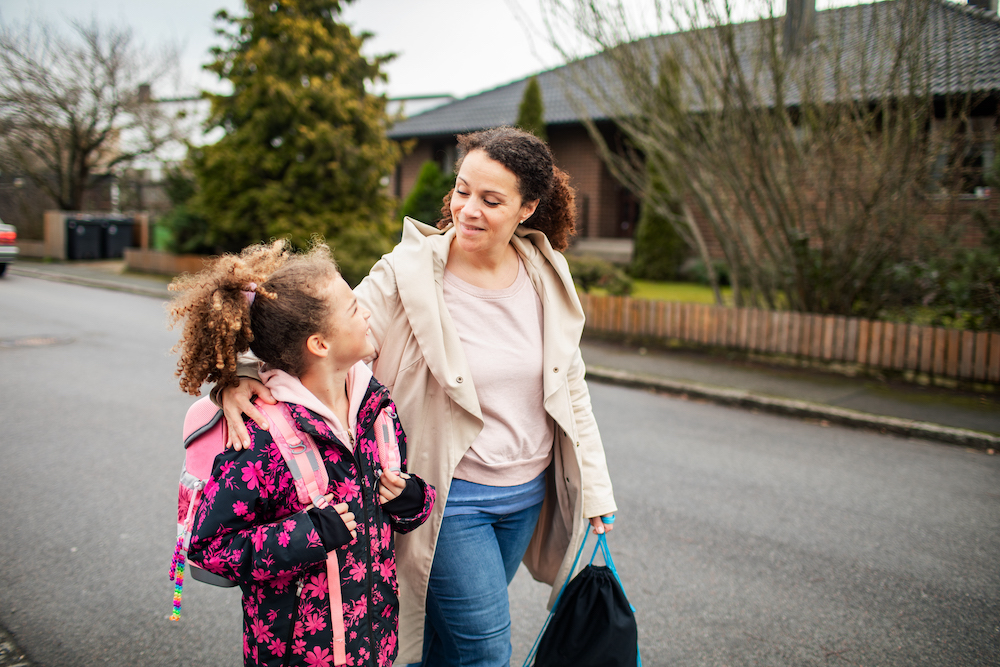Spotting and easing your child’s back-to-school anxiety

Back-to-school anxiety is normal for most kids. Here’s how to prepare them for the new year.
Returning to school after summer break can be a stressful time for children. Back-to-school anxiety is often rooted in a fear of the unknown, and the start of a new school year presents many uncertainties. New teachers may have classroom rules that differ from a child’s previous teachers. Some kids may worry that their friends won’t be in their classes and that they will not know the other students. Lunchtime can be a source of anxiety, too, as children wonder if they will have to sit alone.
Back-to-school anxiety can also be triggered by a previous experience with bullying. Anderson et al. (2022) found that “youth who experienced bullying were more likely to have higher symptoms of depression and anxiety and lower resilience [1].” A child who has been bullied may be more prone to feelings of anxiety at the beginning of a new school year when they return to the place where they were bullied.
Signs of back-to-school anxiety
As the summer comes to an end, it’s important for you to be on the lookout for signs that your child may be struggling with returning to school. Some level of anxiety about starting something new is normal. However, according to a blog post on this subject from parentii.com, adults should pay particular attention to signs that may indicate a child’s anxiety is cause for concern, including:
- Avoidance. A child may avoid new or challenging situations.
- Physical distress. A child may frequently complain of headaches, stomachaches, or other physical ailments. They may have difficulty sleeping.
- The anxiety is chronic and persistent. A child may exhibit constant fear and worry [2].
How to help with your child’s anxiety or stress
If you observe any of these signs in your child, you may want to consider consulting with your child’s pediatrician or seeking professional behavioral health treatment. In addition, you can help children manage their anxiety using these techniques:
- Journaling can help organize your child’s thoughts and work through anxious feelings. Smyth et al. (2018) found that after one month, study participants who engaged in journaling had fewer depressive symptoms and less anxiety than participants who engaged in usual care [3].
- Grounding exercises can help calm your child in the moment by distracting them from anxious thoughts. Have them try the 5-4-3-2-1 technique—name 5 things you see, 4 things you feel, 3 things you hear, 2 things you smell, and 1 thing you taste.
- Physical activity has been shown to significantly reduce the symptoms of anxiety [4].
UPMC Health Plan is available to support pediatric members with behavioral health issues. To find out what supports and services are available, visit upmchealthplan.com/members/learn/benefits-and-services/behavioral-health.aspx.
If you or your child are in crisis, please call 911, call or text 988 for the Suicide & Crisis Lifeline, go to the nearest emergency room, or call the local ambulance service.
- Anderson JR, Mayes TL, Fuller A, et al. Experiencing bullying’s impact on adolescent depression and anxiety: Mediating role of adolescent resilience, Journal of Affective Disorders, 2022.
- admin. ANXIETY IN CHILDREN – WHAT’S NORMAL AND WHAT NOT. parentii. Published May 28, 2019. Accessed July 29, 2023. parentii.com/2019/05/28/anxiety-in-children-whats-normal-and-what-not/
- Smyth JM, Johnson JA, Auer BJ, et al. Online Positive Affect Journaling in the Improvement of Mental Distress and Well-Being in General Medical Patients With Elevated Anxiety Symptoms: A Preliminary Randomized Controlled Trial. JMIR Ment Health. 2018 Dec 10;5(4):e11290. doi: 10.2196/11290. PMID: 30530460; PMCID: PMC6305886.
- Kandola A, Stubbs B. Exercise and Anxiety. Adv Exp Med Biol. 2020;1228:345-352. doi: 10.1007/978-981-15-1792-1_23. PMID: 32342469.



